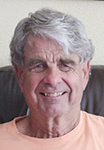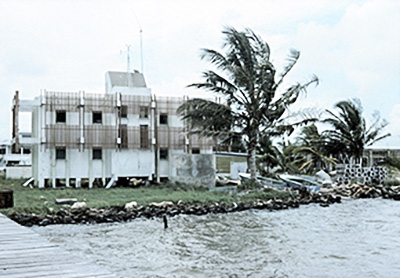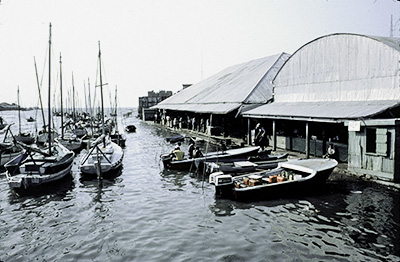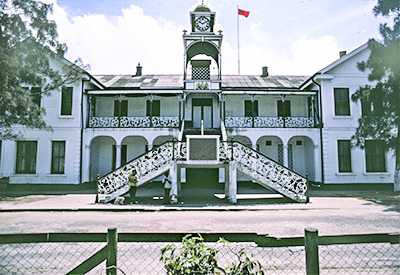“Hurricane Greta” by Alan Jackson (Belize)


Alan Jackson
I was a Peace Corps Volunteer assigned to the Fisheries Unit Laboratory in Belize City from August 1976 to October 1978. Initially I stayed in a small boarding house on Prince Street during a four-week Peace Corps orientation. After that I was expected to find my own housing. My monthly stipend was BZ$300 (US$150) a month, which would have to cover all my living expenses. Most Peace Corps Volunteers in Belize City doubled or tripled up and shared flats wherever they could find reasonable rent.
I had heard good things about a family that had just hosted two Volunteers during our orientation. One of those Volunteers decided to continue boarding with that family while the other was moving to his jobsite in San Antonio, Toledo District. I asked the family if I could board with them, and they welcomed me into their home. They were a young and charming couple with two daughters, 3 and 4 years old. They had recently moved into a large, two-story cement house on Euphrates Avenue between King and Dean Streets. I stayed with them for the rest of my two years in Belize.
— Alan Jackson
•
Hurricane Greta
I WOKE UP EARLY on the morning of Sunday, September 17, 1978, and thought briefly about the impending danger of Hurricane Greta.
I quickly wrote my weekly letter home. Instead of keeping a journal, I took time every Sunday morning, while still in bed, to write to my parents back in Southern California about the events of the preceding week. I knew that my mother would be saving these letters and that I would have them later to help me remember my time as a Peace Corps Volunteer in Belize. I folded, addressed, and sealed the pale blue aerogram, got dressed, slipped the aerogram into my pants pocket and went downstairs for breakfast. After breakfast, I left the house through the front door, and stepped out onto Euphrates Avenue. Our house stood right on the edge of this busy street. There was no setback or front yard. Once I stepped out of the house through that front door in the morning, I was immediately thrust into the community.
Euphrates Avenue was a wide street, by Belizean standards, that ran north and south and funneled Southside Belize City traffic to the Western Highway as well as toward Swing Bridge and the Northside. There was an eclectic mix of ramshackle houses, shops, bars and churches packed tightly along both sides of the street.
Immediately across the street from our house was a small, unnamed shop that sold canned goods, rice, dry beans, seasonings, ham and Dutch cheese by the slice, mosquito repellent and, most importantly for me, 12-ounce glass bottles of ice-cold Coca Cola. This was the kind of neighborhood shop, common in Belize City, that was too small to allow customers to enter. Instead, people were served over a counter that was open to the street or sidewalk. Customers would walk up to the counter and tell the shopkeeper what they wanted to buy. One or two cents change due on a purchase was settled by using penny candy instead of coins.
The proprietor of the shop was Don Salva. Don Salva sat on a chair just behind the counter and waited for his customers. He had a tabletop electric fan and a radio tuned to Radio Belize, the country’s only station. Don Salva, a heavyset, balding mestizo, who was always dressed in a white cotton undershirt and khaki pants, lived upstairs of his small shop. I wish I had gotten to know Don Salva better during the two years that I lived across the street from him, but he was not a talkative person, and neither was I.
Two doors up from our house, and on the same side of the street, was the Haven Club. The Haven Club occupied the upper floor of a two-story building. Downstairs was a Cuello Brothers rum distributorship. The Haven Club was a quiet neighborhood bar from Sunday through Thursday. On Friday and Saturday nights, however, the place came alive. On those nights, the most popular bands in the city played there.
My bedroom window opened onto the Haven Club, and at that time almost no home or business had air conditioning, so on those hot, humid nights every window in the city was wide open. That meant that I could hear music coming out of the Haven Club as clearly and as loudly as if I were listening to recorded music at full volume in my own bedroom. I became so familiar with each band’s set list that I knew which song would be played next.
HURRICANE GRETA WAS TRACKING toward Belize, and I would have to report to the Fisheries Unit Laboratory later in the day to help prepare for it, but in the meantime, I had arranged to meet fellow Peace Corps Volunteer Matt Connor that morning to walk with me around the city and shoot some photographs. Matt had a high-quality Nikon camera and he had agreed that, if I supplied the film, he would take the pictures. My two years in Belize would be ending in three weeks, and I wanted to get a few more pictures of the city before I left.
Matt was a memorable character. He was funny, outgoing, good-looking and smart. He was also a stylish dresser and stood out from the rest of us Peace Corps Volunteers by wearing crisply starched and ironed button up shirts instead of the de facto Peace Corps “uniform” of faded tee shirts and jeans. Soon after arriving in Belize, Matt began dating the daughter of his host family and bought an old car to drive her to and from work. He was the only Volunteer who had his own car, which was strictly against Peace Corps policy. Matt had previously been a Peace Corps Volunteer in Malaysia, but was abruptly reassigned to Belize for reasons left only to our speculation.

The Fisheries Lab from Swing Bridge
Neither Matt nor I had enough money to buy gas for his car, so we agreed to meet on the edge of town at the Fisheries Unit Laboratory on Princess Margaret Drive, and we would start our photo shoot on foot from there. It was a beautiful morning with a powder blue sky splotched with large white clouds, and there was a light breeze coming out of the north. I did not mind the 30-minute walk to meet Matt.
From Euphrates Avenue I turned right onto King Street, crossed over the canal where I noticed a young girl emptying a white enameled bucket, walked past Dit’s restaurant and Pino’s barbershop and then turned left onto Albert Street. As I crossed Swing Bridge over Haulover Creek, I could smell the sea and feel the air temperature drop a couple of degrees. I always looked forward to the small respite from the tropical heat that the creek provided. I crossed North Front Street to the post office where there were two poor souls in the sheltered entrance sleeping off their Saturday night bender of cheap rum. I dropped my aerogram in the mail slot and continued down Queen Street. At the Majestic Theater I turned left onto Barrack Road and in less than ten minutes I was at the seafront and felt its cooling breeze. It was just a short and pleasant walk along the water’s edge from there to Fisheries. I could see that Matt was already there, sitting on the front steps waiting for me.
After quickly exchanging greetings, Matt and I left the Fisheries compound and walked south along Barrack Road back toward town. We stopped to take pictures of Sea View Hospital, the Gahne Town Clock on Barrack Road, Her Majesty’s Prison on Gaol Lane, St. Catherine Convent and the U.S. Consulate on Gabourel Lane, the Peace Corps Office on Cork Street, the Paslow Building, the Price home on Pickstock Street, Holy Redeemer Cathedral, Swing Bridge and the Old Market.

Belieze Fish Market from the bridge
At Market Square, Matt pointed to the large, revolving Coca Cola clock and ranted about the crassness of American consumerism and how Madison Avenue logos and symbols are defiling the Third World.
We walked 100 yards or so along Regent Street from the Coca Cola clock to the Courthouse, a two-story, cupula-topped structure with a grand outdoors staircase and ornate ironwork. There were two bedraggled creole men standing in the shade cast by the staircase, their filthy bedding unfurled on the ground beside them.

Courthouse with red flag hurricane warning
Looking up, we saw a single red flag flying high above the Courthouse signaling that Belize City was now officially under a hurricane watch. Both Regent and Albert streets in the commercial heart of the Old Capital were nearly deserted, which was not unusual for an early Sunday morning. The stillness of the city, combined with the sight of the red hurricane watch flag, gave us an ominous feeling, and we decided to end our photo shoot early. I needed to report to Fisheries in an hour or so, anyway, to help with hurricane preparations.
Bulletins on the status of Hurricane Greta were being issued every 15 minutes over Radio Belize even though the underlying information coming from the U.S. National Hurricane Center was only being updated at two-hour intervals. The latest bulletin indicated that Hurricane Greta was moving west-northwest just off the coast of Honduras at 12 to 15 miles per hour toward Belize.
Winston Miller, the Fisheries Administrator, had left the country two days earlier for meetings in Washington, D.C., and before he left, he put Senior Fisheries Officer Janet Gibson in charge.
Janet called the Fisheries staff in to work at noon. She outlined what we would have to do to be ready for Greta. The Fisheries Laboratory stood just 50 feet from the water’s edge and was susceptible to a storm surge. We all pitched in and put up the storm shutters on the windows. Even though there were about 30 windows the task was not too difficult because each window was clearly numbered and matched to a numbered shutter. We cleared off desktops and filed away our paperwork. We knew where the roof leaked, so we placed pigtail buckets under those spots. We looked around the yard and secured or brought inside anything that might be swept away in the storm.
We pulled the two wooden skiffs up into the yard as far as we could.
Recently authorities had seized two Honduran sloop-rigged smacks that were caught fishing illegally in Belizean waters. These two sailboats were being temporarily moored behind Fisheries alongside our research vessel, the Panulirus Argus. Our boat captain, Romie Badillo, was in Canada taking a course in advanced ship handling and navigation, so Janet arranged for a boat captain from the Customs Department to take all three vessels up Haulover Creek and beyond Swing Bridge to safety. The plan was to have the captain from Customs pilot the Panulirus Argus and tow the two sailboats behind. I would be at the tiller of one of the sailboats and Dwight Neal would be at the tiller of the other. Neither Dwight nor I was an experienced boatman, so this was bound to be a tricky operation.
About 2:00 in the afternoon the boat captain from Customs arrived and started up the engine on the Panulirus Argus. Dwight and I untethered the two sailboats from their moorings, secured a towline between them and another to the stern of the Panulirus Argus. The captain released the Panulirus Argus’s mooring line, shifted out of neutral and pulled ahead slowly. The slack went out of the towlines with a sudden jerk. Like a mother duck leading her two ducklings, we slowly made our way to the mouth of the harbor, a distance of two miles.
As we rounded Fort Point and entered the harbor, we could see boats stacked up five and six abreast waiting for the bridge to swing open. After a lot of jostling and maneuvering we took our place among the other boats. Despite the incidental bumping and scraping of boat against boat, no one seemed vexed. There was a kind of camaraderie among the boatmen as though we were all in this together. The bridge swung open and we joined the parade of boats squeezing between the bridge and the concrete river embankment. We finally secured the three boats a short distance up the river at the Davis boatyard, and my workday was done.
THE NEXT MORNING, Monday, I reported back to work at Fisheries. My means of transportation to and from work changed over the course of my two years in Belize. All Peace Corps Volunteers stationed in Belize City were given a new Raleigh bicycle. A bicycle is an excellent means of transportation in Belize City because the landscape is perfectly flat, and you can easily bike across town in just a few minutes. Unfortunately, my bicycle was stolen within the first few months and was never recovered.
Soon after my bicycle was stolen, I was given permission to drive the Fisheries Land Rover to and from work. This was a fine arrangement for a few weeks until the Land Rover was sent to Dangriga for major repairs and remained there for many months.
The Forestry Department maintained a small staff at the Fisheries Laboratory, and its secretary, Desiree Leslie, lived on King Street just around the corner from me. She was given a ride to work each day by her boss, Lionel Gentle, in the Forestry Land Rover pickup truck. I found that I could wait at Desiree’s front gate for Mr. Gentle to show up and then jump in the back of the pickup while Desiree rode up front with Mr. Gentle. That arrangement lasted until I left Belize. I slowly graduated from waiting at Desiree’s front gate, to waiting on her verandah, to sitting in her parlor, to taking tea and chatting with the family. They were genuinely nice people.
I arrived at Fisheries and helped with a thorough, last minute inspection of the laboratory and grounds. At about 9:00 Janet dismissed the staff so that they could be with their families and prepare their homes for the hurricane or head to the shelters that would open at noon. Janet asked me, however, because I had no home or family in Belize, to remain at Fisheries. My job would be to maintain VHF radio contact with the Forestry Office at Augustine and then, before the Northern Road became impassable, to drive the Fisheries Land Rover to the Belize International Airport where it would be safe from coastal flooding. I considered my host family as my actual family, and I was devoted to them. I was tempted to tell Janet that I really should go home to help them prepare instead of taking care of Fisheries. But, really, Janet was in a bind, and I felt obliged to help.
By mid-afternoon, the breeze was picking up, and around 4:00 it started to rain. The yard in front was filling with water, and waves were dashing up against the planking of the little pier in the back. Sunset would not be until 5:50, but the sky already seemed to be darkening. At 5:00 I contacted Augustine Forestry Station to let them know that I was about to shut down the radio and take the Land Rover to the airport.
The two-lane Northern Road to the airport was paved, but it was without shoulders, center striping or warning signs. For most of the eight miles to the airport it ran through open landscape, but large trees did line the road in some areas. And for three miles the road ran perilously close to the Belize River.
I jumped in the Land Rover and started to drive out of the Fisheries compound. I immediately had a sinking feeling that maybe I was leaving for higher ground a little too late. I wasn’t sure that I would be able to make it to the airport before the Northern Road flooded, especially along the stretch just north of Haulover Bridge where the distance between the Belize River and the Caribbean Sea is only about a hundred yards.
To my relief, the drive to the airport was without incident. The water had not yet risen much, although there were five or six inches of water in some areas. Otherwise, the road was clear with just a small amount of tree branch and leaf litter on it. At the airport I parked and locked up the Land Rover. Then I started to wonder, “Now what am I supposed to do?” Funny, but that was the first time I had even thought about having to spend the night alone at the airport. I really wanted to go back home and be with my host family. I knew that they could use my help, especially with lifting heavy items up off the downstairs floor.
IT WAS NOW DARK and the wind was gusting strongly. I looked around the airport grounds and noticed that someone had just turned on the headlights of a red and white pickup truck and was getting ready to leave the airport. I flagged the truck down and asked the driver where he was going. He told me that he was hoping to make it back to Belize City. I noticed two other people with the driver in the cab. I asked if I could get a ride, and he told me to hop into the back. I got into the truck bed and tapped on the top of the cab, “Let’s go!”
The pickup truck headed out of the airport grounds and toward the Northern Road. I hunkered down in the bed and leaned up against the cab.
Just then it began to rain. I was wearing only a tee shirt and jeans and did not have a jacket with me. We turned onto the Northern Road and began to make our way toward the city. Almost immediately I realized that the odds of making it to Belize City were not good. I did not know it at the time, but Hurricane Greta had just come ashore about 20 miles to the south.
It was now raining harder, and I was thoroughly soaked and becoming cold. Within a mile we encountered 12 to 18 inches of water on the road. We pressed slowly on, dodging what looked like the deepest water and hoping for the best. Somewhere just before reaching Haulover Bridge, the pickup dropped into a large pothole, water poured into the engine compartment, and that was it. The engine stalled and could not be restarted.
Just then, and before I could fully appreciate our predicament, a Belize Defense Force Bedford 4-ton, high clearance truck, coming from the opposite direction, drove up to us and came to a stop. A soldier got out of the truck to check on us. He said that they were going to Airport Camp and that we should go with them. Without hesitation I climbed into the back of the large truck which had a canvas canopy. The driver of the pickup said that he thought the worst of the hurricane was over and that he and his two companions would stay with his vehicle.
The BDF truck pulled away from the stranded pickup truck, and we were on our way to Airport Camp. Even though the wind had now died down somewhat, the road was littered with tree branches. Several times along the way, the road was blocked by large fallen trees, and the soldiers got out with machetes and a chainsaw to clear the way. It took nearly three hours to go the four miles to Airport Camp.
We finally pulled into Airport Camp, and I was ushered into a building and then into a small, unfurnished room with a bare concrete floor and given a folding metal chair to sit on. I was told that this was the stockade, but that I would not be locked up. The soldier said that I could stay there until morning. He also promised to bring me a blanket and a bowl of hot soup. He then left, and I was alone. I was cold, wet and hungry, and I looked forward to drying off and warming up with the soup, but nobody returned to check on me. I was left there alone for the duration of the night.
AS SOON AS I SAW the first light of morning, I let myself out of my cell and walked to the airport where I had left the Land Rover the night before. I was now somewhat dry and not too cold, and I was happy to be going home. Much to my relief, the Land Rover started right up, and I drove out from the airport. The water on the Northern Road had receded. The road, muddy and littered with debris, was passable and, except for me, deserted. As I entered the city and approached Central American Boulevard, I did not immediately see any hurricane damage, just a thick layer of mud on the streets. As I crossed over Belcan Bridge I looked to my left along Haulover Creek toward downtown, and I saw some houses that were severely damaged if not destroyed. I did not see anyone on the streets. The city seemed eerily deserted.
I reached home to find my host family finishing up scraping the mud from the lower floor of their two-story home. They had help from the 10 or 12 members of their extended family who spent the night in their solid cement house. The flood water left a mark that went 18 inches up the walls. There was no apparent damage to the outside of the house, and by evening the inside of the house was clean and dry.
I DO NOT REMEMBER much about the aftermath of Hurricane Greta. I guess I was more focused on wrapping up my two-year Peace Corps stint in Belize and making plans to return home to California. I do recall that the pilot house of the Panulirus Argus was ripped from the deck and splintered, possibly from a tornado that touched down briefly along Haulover Creek in that part of the city. The two wooden skiffs left in the Fisheries yard ended up in the next property to the north. The inside of the Fisheries Unit Laboratory was wet but not damaged.
My lasting memory of Greta, however, is of the thick, sticky, putrid, black mud that was deposited on the city. In the mid-1970s many homes in Belize City were not connected to a septic tank or a sewer system. Residents of those homes disposed of wastewater on the ground or in the bushes and emptied their chamber buckets into the canals that crisscrossed the city or directly into the streets’ gutters, known locally as “drains.” Also, there were public toilets built cantilevered over the canals. This raw sewage, human feces and all, slowly flowed from drain to canal and finally into the harbor and the nearshore sea where it settled to the bottom, festered and accumulated since the last hurricane, Hattie, in 1961. Hurricane Greta scooped up 17 years’ worth of this muck and threw it right back onto the city’s streets, yards and open spaces. The resulting stench was pervasive and persistent. The mud remained on Belize City streets, fetid and foul, for days. In fact, when I left Belize for the States three weeks later the streets were still covered with this mud.
Hurricane Greta Statistics
Hurricane Greta was the seventh named storm of the 1978 Atlantic hurricane season. Greta formed from a tropical wave just northwest of Trinidad on September 13 and gradually intensified while moving west-northwestward. On September 16, it became a hurricane south of Jamaica. Two days later, the well-defined eye approached northeastern Honduras but veered to the northwest. After reaching peak winds of 130 mph that day, Greta weakened while paralleling the northern Honduras coast just offshore. On Monday, September 18, at 6:00 PM local time, it made landfall in Belize between Dangriga and Belize City.
At Greta’s final landfall in Belize, the highest sustained winds were 55 mph in Belize City with gusts to 80 mph. Tides were 2 to 4 ft. above normal in Belize City, which caused flooding in conjunction with swollen rivers. The United States consulate was flooded with about one foot of mud.
There was little damage in the city, although a tornado in Belize City damaged four houses and flipped over a truck. During the storm, the Belize International Airport was closed. Damage throughout Belize was estimated at $25 million (1978 USD), and there were four deaths. Three of the deaths were on offshore islands in areas without radios, and the other was due to electrocution.
Finely related account, Alan… brought back a lot of memories. I was the APCD there from 1972-74 and my daughter was born there.. what were we thinking? … Rob Thurston
… Rob Thurston
Rob, thanks for reading my story. I hope it brought back some good memories. Do you remember Louis Lindo, Barbara Harris, Alicia Zea or Eugene Godoy? They were Peace Corps staff when I arrived in 1976.
Alan, I enjoyed reading your detailed account of your time in Belize City. My Peace Corps group arrived in the Fall of 1977. I lived in the city a block from the sea wall and Hurricane Greta was my first experience of a hurricane. I now live in South Texas near Padre Island and have had many more hurricane adventures. I loved Belize so much that after my 2 years working at the Teachers College, I found a teaching job at St Catharine for an additional year. Readjusting to life in the states afterward was the bigger culture shock I found your post thanks to a Belizean friend with whom I have kept in touch.
I remember my bicycle and bus riding and hitching rides in the back of pick-ups. Making a single phone call over the course of 3 years, and writing on those blue aerograms. Mostly I loved the friendliness and generosity of the local folks including my host family, Norma and Douglas Fairweather.
Ruth Wessling (Glassco)
Ruth, I’m glad you enjoyed my story, and I hope it brought back pleasant memories. Yes, readjusting to life back in the States took a while. I was forever changed by my 2 years in Belize. I am married to a Belizean, and we visit her family in Belize every year. It has changed a lot since you were there.
just read your account and brings back memories of that weekend. I would say that the vehicle that picked you up was a british army 4 tonner and you spent the night in the guardroom at the British army base at Airport Camp. BDF were formed in Jan 1978 but as Belize didn’t get its independence until 1981 there was a strong military presence due to threats from Guatamala. We were still there long after independence and still have a presence.